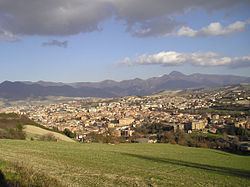Demonym(s) Fabrianesi Elevation 325 m | Frazioni see list Time zone CET (UTC+1) Local time Sunday 12:09 AM Postal code 60044 | |
 | ||
Weather 4°C, Wind E at 6 km/h, 49% Humidity | ||
Fabriano is a town and comune of Ancona province in the Italian region of the Marche, at 325 metres (1,066 ft) above sea level. It lies in the Esino valley 44 kilometres (27 mi) upstream and southwest of Jesi; and 15 kilometres (9 mi) east-northeast of Fossato di Vico and 36 kilometres (22 mi) east of Gubbio (both in Umbria). Its location on the main highway and rail line from Umbria to the Adriatic make it a mid-sized regional center in the Apennines. Fabriano is the headquarters of the giant appliance maker Indesit.
Contents
- Map of 60044 Fabriano Province of Ancona Italy
- History
- Geography
- Frazioni
- Main sights
- Churches
- Other buildings
- Personalities
- References
Map of 60044 Fabriano, Province of Ancona, Italy
Fabriano, with Bologna, is the only Italian creative city (UNESCO). The town is in the category Folk Arts (for the Fabriano's handmade paper production).
History
Fabriano appears to have been founded in the early Middle Ages by the inhabitants of a small Roman town 5 kilometres (3 mi) south at Attiggio (Latin Attidium), of which some slight remains and inscriptions are extant. Fabriano itself was one of the earliest places in Europe to make high-quality paper on an industrial scale, starting in the 13th century, and the town even today has a reputation for fine watermarked paper. This led to Fabriano's prosperity in the Late Middle Ages and the Renaissance, and was also one of the factors that led to the establishment of nearby Foligno in Umbria as one of the earliest printing centers in Italy in the 15th century, from 1470 onwards.
Geography
The municipality borders with Cerreto d'Esi, Costacciaro (PG), Esanatoglia (MC), Fiuminata (MC), Fossato di Vico (PG), Genga, Gualdo Tadino (PG), Matelica (MC), Nocera Umbra (PG), Poggio San Vicino (MC), Sassoferrato, Serra San Quirico and Sigillo (PG).
Frazioni
The hamlets (frazioni) of Fabriano are:
Albacina, Argignano, Attiggio, Bassano, Bastia, Belvedere, Borgo Tufico, Cacciano, Ca' Maiano, Campodiegoli, Campodonico, Cancelli, Cantia, Castelletta, Ceresola, Ciaramella, Coccore, Collamato, Collegiglioni, Colle Paganello, Cupo, Fontanaldo, Grotte, Marena, Marenella, Marischio, Melano, Moscano, Nebbiano, Paterno, Poggio San Romualdo, Precicchie, Rocchetta, Rucce, San Donato, San Giovanni, San Michele, San Pietro, Sant'Elia, Serradica, Valgiubbola, Vallemontagnana, Valleremita, Vallina, Varano, Viacce, Vigne.
Main sights
Fabriano's wealth and commitment to the fine arts in the late medieval period have left it with many monuments.
